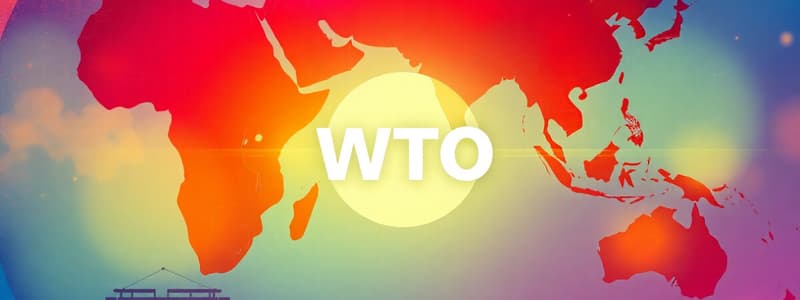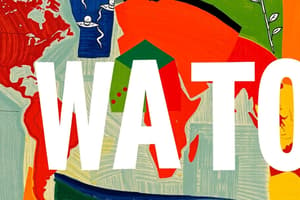Podcast
Questions and Answers
What was a key factor in the shift from British to American hegemony in the early twentieth century?
What was a key factor in the shift from British to American hegemony in the early twentieth century?
- The decline of the British navy and the rise of the United States Navy.
- The rise of new economic powers, such as Japan and Germany.
- The United States' willingness to use its economic power to rebuild the global economy after World War I.
- The British Empire's inability to recover economically from World War I. (correct)
What was a major consequence of the United States' reluctance to fully utilize its economic power after World War I?
What was a major consequence of the United States' reluctance to fully utilize its economic power after World War I?
- The development of new technologies that increased global trade.
- The emergence of the World Trade Organization as a global trade regulator.
- The decline of the United States' industrial output.
- The rise of protectionist trade policies and the Great Depression. (correct)
How did the emergence of developing countries as a powerful bloc within the WTO change the organization's decision-making process?
How did the emergence of developing countries as a powerful bloc within the WTO change the organization's decision-making process?
- It created a more equitable distribution of power and influence within the organization.
- It led to a more unified and cohesive approach to global trade negotiations.
- It made decision-making more complex and challenging due to competing interests. (correct)
- It resulted in a significant increase in the number of trade agreements negotiated.
What was a major concern raised by developing countries regarding the first effort to launch the current round of WTO negotiations in Seattle in 1999?
What was a major concern raised by developing countries regarding the first effort to launch the current round of WTO negotiations in Seattle in 1999?
What industries did industrialized countries generally liberalize during the early years of the WTO?
What industries did industrialized countries generally liberalize during the early years of the WTO?
What was a key consequence of the dominance of industrialized countries in early WTO negotiations?
What was a key consequence of the dominance of industrialized countries in early WTO negotiations?
What is a key feature of the evolving role of non-governmental organizations (NGOs) in the WTO?
What is a key feature of the evolving role of non-governmental organizations (NGOs) in the WTO?
How has the emergence of developing countries and NGOs impacted the WTO?
How has the emergence of developing countries and NGOs impacted the WTO?
What was the primary focus of the initial negotiations under the Doha Agenda?
What was the primary focus of the initial negotiations under the Doha Agenda?
What was the primary demand of developing countries in relation to agriculture during the Doha negotiations?
What was the primary demand of developing countries in relation to agriculture during the Doha negotiations?
Which issue did the EU insist needed to be addressed alongside agriculture in the Doha Agenda?
Which issue did the EU insist needed to be addressed alongside agriculture in the Doha Agenda?
What was one of the two main goals of the Doha negotiations?
What was one of the two main goals of the Doha negotiations?
What does the WTO's dispute settlement mechanism facilitate?
What does the WTO's dispute settlement mechanism facilitate?
According to hegemonic stability theory, what is the WTO's stability contingent upon?
According to hegemonic stability theory, what is the WTO's stability contingent upon?
What are public goods theory and hegemonic stability theory both used to explain?
What are public goods theory and hegemonic stability theory both used to explain?
What action is required if a government is found to be in violation of WTO rules?
What action is required if a government is found to be in violation of WTO rules?
What is a primary role of a hegemon in the context of international trade?
What is a primary role of a hegemon in the context of international trade?
What happens to the free-riding problem when a hegemon is present?
What happens to the free-riding problem when a hegemon is present?
Which historical period is associated with the rapid growth of world trade under clear hegemony?
Which historical period is associated with the rapid growth of world trade under clear hegemony?
How does hegemonic transition affect the world trade system?
How does hegemonic transition affect the world trade system?
What significant role did the United States play after World War II in trade?
What significant role did the United States play after World War II in trade?
What effect did British hegemony have on the global economy in the 19th century?
What effect did British hegemony have on the global economy in the 19th century?
What are the characteristics of public goods that are related to the WTO?
What are the characteristics of public goods that are related to the WTO?
What happens to world trade as a hegemon declines in power?
What happens to world trade as a hegemon declines in power?
What is a primary goal of NGOs in relation to the WTO's rules?
What is a primary goal of NGOs in relation to the WTO's rules?
What is a characteristic of a free trade area?
What is a characteristic of a free trade area?
What is the primary decision-making process within the WTO?
What is the primary decision-making process within the WTO?
How have regional trade arrangements (RTAs) impacted the WTO?
How have regional trade arrangements (RTAs) impacted the WTO?
What is the primary goal of intergovernmental bargaining in the WTO?
What is the primary goal of intergovernmental bargaining in the WTO?
Which statement best describes a customs union?
Which statement best describes a customs union?
What role does the WTO Ministerial Conference play in the negotiation process?
What role does the WTO Ministerial Conference play in the negotiation process?
What is one criticism levied by civil society groups against the WTO?
What is one criticism levied by civil society groups against the WTO?
What is a key characteristic of the Doha Round's 'single undertaking' principle?
What is a key characteristic of the Doha Round's 'single undertaking' principle?
What is a result of liberalization in trade among the US, EU, and Japan?
What is a result of liberalization in trade among the US, EU, and Japan?
What trend has been observed among NGOs since the late 1990s regarding WTO rules?
What trend has been observed among NGOs since the late 1990s regarding WTO rules?
Which of the following is NOT an area that the Doha Round focused on?
Which of the following is NOT an area that the Doha Round focused on?
Which is a reason why the agreement on the Doha Round agenda matters?
Which is a reason why the agreement on the Doha Round agenda matters?
Which of the following represents a similarity between the US, EU, and Japan in trade liberalization?
Which of the following represents a similarity between the US, EU, and Japan in trade liberalization?
Which of the following are NOT examples of non-tariff barriers?
Which of the following are NOT examples of non-tariff barriers?
Which of the following is a goal that the Doha Round aimed to achieve?
Which of the following is a goal that the Doha Round aimed to achieve?
What is a primary concern regarding RTAs in relation to the WTO?
What is a primary concern regarding RTAs in relation to the WTO?
What percentage of RTAs in operation is accounted for by agreements in Europe and the Mediterranean?
What percentage of RTAs in operation is accounted for by agreements in Europe and the Mediterranean?
Which event marked the beginning of the first wave of RTAs?
Which event marked the beginning of the first wave of RTAs?
Which wave of RTAs was primarily influenced by trade policy reforms in Eastern and Central Europe?
Which wave of RTAs was primarily influenced by trade policy reforms in Eastern and Central Europe?
In what year did Moldova enter RTAs with other newly independent countries from the former Soviet Union?
In what year did Moldova enter RTAs with other newly independent countries from the former Soviet Union?
How did the EEC contribute to postwar recovery after World War II?
How did the EEC contribute to postwar recovery after World War II?
What was a key motivation for the first wave of RTAs?
What was a key motivation for the first wave of RTAs?
What percentage of RTAs is accounted for by North and South America?
What percentage of RTAs is accounted for by North and South America?
Flashcards
Intergovernmental bargaining
Intergovernmental bargaining
The primary decision-making process in WTO for negotiating trade agreements.
Liberalize trade
Liberalize trade
To reduce or eliminate policies that restrict cross-border trade.
Tariffs
Tariffs
Taxes imposed by governments on foreign goods entering the country.
Non-tariff barriers
Non-tariff barriers
Signup and view all the flashcards
Ministerial Conference
Ministerial Conference
Signup and view all the flashcards
Doha Round
Doha Round
Signup and view all the flashcards
Singapore Issues
Singapore Issues
Signup and view all the flashcards
Single undertaking
Single undertaking
Signup and view all the flashcards
Doha Agenda
Doha Agenda
Signup and view all the flashcards
Obstacles to Doha
Obstacles to Doha
Signup and view all the flashcards
Developing countries' demands
Developing countries' demands
Signup and view all the flashcards
EU's insistence on Singapore issues
EU's insistence on Singapore issues
Signup and view all the flashcards
WTO Dispute Settlement Mechanism
WTO Dispute Settlement Mechanism
Signup and view all the flashcards
Compliance in WTO
Compliance in WTO
Signup and view all the flashcards
Hegemonic Stability Theory
Hegemonic Stability Theory
Signup and view all the flashcards
Public Goods in Trade
Public Goods in Trade
Signup and view all the flashcards
Free Riding
Free Riding
Signup and view all the flashcards
WTO and Public Goods
WTO and Public Goods
Signup and view all the flashcards
Hegemon
Hegemon
Signup and view all the flashcards
Public Goods Provision
Public Goods Provision
Signup and view all the flashcards
Hegemonic Leadership
Hegemonic Leadership
Signup and view all the flashcards
Hegemonic Transition
Hegemonic Transition
Signup and view all the flashcards
GATT
GATT
Signup and view all the flashcards
American hegemony
American hegemony
Signup and view all the flashcards
Post-WWII manufacturing
Post-WWII manufacturing
Signup and view all the flashcards
Great Depression impact
Great Depression impact
Signup and view all the flashcards
World Trade Organization (WTO)
World Trade Organization (WTO)
Signup and view all the flashcards
Developing countries bloc
Developing countries bloc
Signup and view all the flashcards
Seattle negotiations 1999
Seattle negotiations 1999
Signup and view all the flashcards
Liberalization of agriculture
Liberalization of agriculture
Signup and view all the flashcards
Negotiating agenda
Negotiating agenda
Signup and view all the flashcards
NGOs
NGOs
Signup and view all the flashcards
WTO rules
WTO rules
Signup and view all the flashcards
Consumer interests
Consumer interests
Signup and view all the flashcards
Regional Trade Arrangements (RTAs)
Regional Trade Arrangements (RTAs)
Signup and view all the flashcards
Free-trade area
Free-trade area
Signup and view all the flashcards
Customs union
Customs union
Signup and view all the flashcards
Producer interests
Producer interests
Signup and view all the flashcards
Civil society groups
Civil society groups
Signup and view all the flashcards
RTAs (Regional Trade Agreements)
RTAs (Regional Trade Agreements)
Signup and view all the flashcards
Discriminatory nature of RTAs
Discriminatory nature of RTAs
Signup and view all the flashcards
WTO (World Trade Organization)
WTO (World Trade Organization)
Signup and view all the flashcards
First wave of RTAs
First wave of RTAs
Signup and view all the flashcards
EEC (European Economic Community)
EEC (European Economic Community)
Signup and view all the flashcards
Second wave of RTAs
Second wave of RTAs
Signup and view all the flashcards
Moldova's RTAs
Moldova's RTAs
Signup and view all the flashcards
EU bilateral RTAs
EU bilateral RTAs
Signup and view all the flashcards
Study Notes
Chapter Objectives
- How global power distribution affects international trade systems
- Contemporary challenges to the WTO
- Role of Non-Governmental Organizations (NGOs)
- Significance of regional trade arrangements
What is the World Trade Organization (WTO)?
- WTO formed in 1995, building on the General Agreement on Tariffs and Trade (GATT) (1947-1994)
- Oversees international trade rules, governing trade relations between countries
- WTO rules are continuously revised, amended, and extended
- WTO is a political system involving rule-making, negotiations, dispute resolution
Core Principles of the WTO
- Most-Favored Nation (MFN): Equal treatment of all member countries in trade policies
- National Treatment: Domestic and foreign goods are treated equally once within a country's market
- Exceptions to MFN: Regional trade agreements (e.g., NAFTA) allow special treatment within a specific region
Processes by which WTO Rules are Created
- Intergovernmental Bargaining: Core process for creating trade agreements
- Agreements directly & indirectly liberalize trade, altering tariffs and non-tariff barriers.
Doha Round
- Agreements focused on tariff reductions (especially for developing countries)
- Integration of service sector negotiations and agricultural trade liberalization
- "Single Undertaking": all aspects of the Doha agenda must be agreed upon
WTO Compliance Mechanisms
- Ensuring government compliance with established rules
- Dispute settlement mechanism resolves disputes via quasi-judicial tribunals
- Sanctions if a government is found violating the rules
Hegemonic Stability Theory
- WTO, and international trade stability, depend on the distribution of power in the global system
- A "hegemon" (dominant power) has incentive to promote open trade, and bear cost of maintaining the rules
Public Goods and Free Riding
- Public goods are non-excludable and non-rivalrous, meaning once provided, everyone benefits, but not all contribute
- Free riding occurs when people rely upon others to contribute, while themselves consuming the public good
- The WTO has characteristics of a public good, and free-riding can hinder its success
Evolving World Trade Organization
- Development of blocs of developing countries increases negotiating power in the WTO
- NGOs (non-governmental organizations) play increasing external role affecting government policy
Regional Trade Arrangements (RTAs)
- These agreements offer alternative ways to organize trade.
- RTAs can be beneficial by creating free trade zones
- RTAs contain both Free Trade Areas and Customs Unions
Trade Creation and Diversion
- Trade creation occurs when free trade agreements create new trade
- Trade diversion occurs when trade is diverted to a free trade zone at the expense of a global trade partnership
Studying That Suits You
Use AI to generate personalized quizzes and flashcards to suit your learning preferences.




